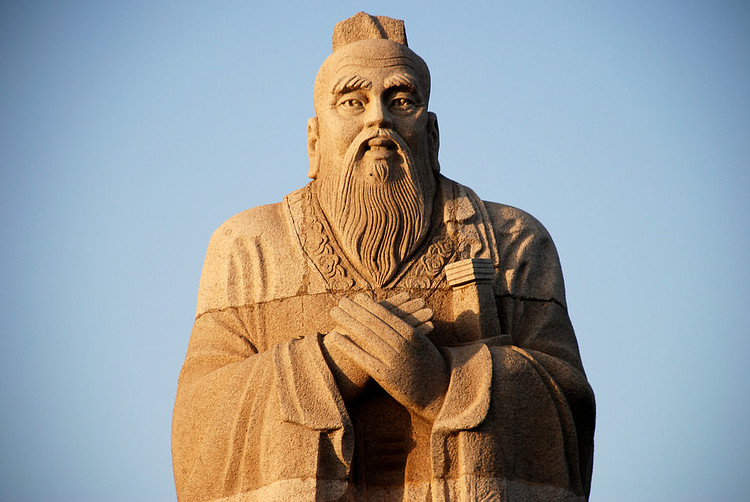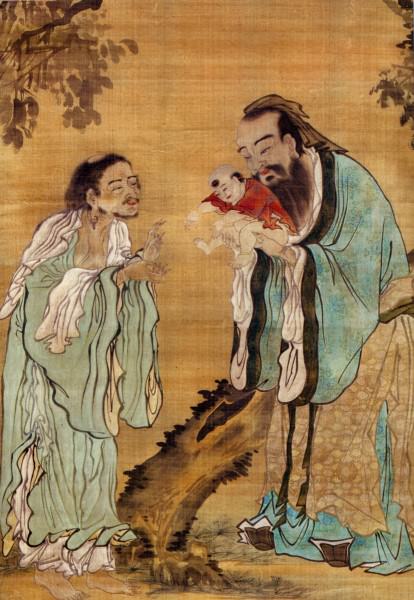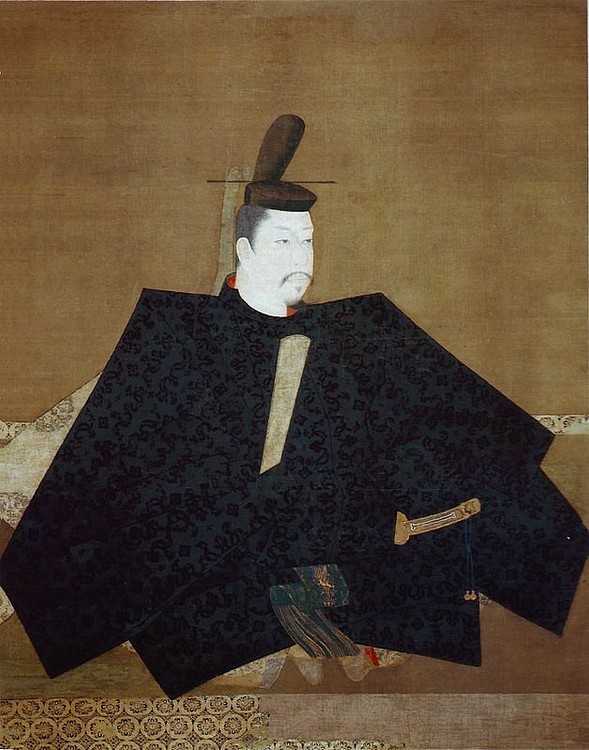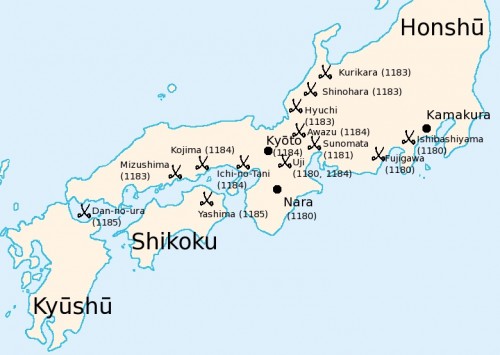Confucius › Genpei War » Ancient origins
Articles and Definitions › Contents
- Confucius › Who Was
- Genpei War › Ancient History
Ancient civilizations › Historical and archaeological sites
Confucius › Who Was
Definition and Origins

Confucius (or Kongzi) was a Chinese philosopher who lived in the 6th century BCE and whose thoughts, expressed in the philosophy of Confucianism, have influenced Chinese culture right up to the present day. Confucius has become a larger than life figure and it is difficult to separate the reality from the myth. He is considered the first teacher and his teachings are usually expressed in short phrases which are open to various interpretations. Chief among his philosophical ideas is the importance of a virtuous life, filial piety and ancestor worship. Also emphasised is the necessity for benevolent and frugal rulers, the importance of inner moral harmony and its direct connection with harmony in the physical world and that rulers and teachers are important role models for wider society.
CONFUCIUS' EARLY LIFE
Confucius is believed to have lived from c. 551 to c. 479 BCE in the state of Lu (now Shandong or Shantung). However, the earliest written record of him dates from some four hundred years after his death in the Historical Records of Sima Qian (or Si-ma Ts'ien). Raised in the city of Qufu (or K'u-fou), Confucius worked for the Prince of Lu in various capacities, notably as the Director of Public Works in 503 BCE and then the Director of the Justice Department in 501 BCE. Later, he travelled widely in China and met with several minor adventures including imprisonment for five days due to a case of mistaken identity.Confucius met the incident with typical restraint and was said to have calmly played his stringed instrument until the error was discovered. Eventually, Confucius returned to his hometown where he established his own school in order to provide students with the teachings of the ancients. Confucius did not consider himself a 'creator' but rather a 'transmitter' of these ancient moral traditions. Confucius' school was also open to all classes, rich and poor.
CONFUCIANISM BECAME THE OFFICIAL STATE RELIGION OF CHINA FROM THE 2ND CENTURY BCE.
CONFUCIUS' WORKS
It was whilst he was teaching in his school that Confucius started to write. Two collections of poetry were the Book of Odes(Shijing or Shi king) and the Book of Documents (Shujing or Shu king). The Spring and Autumn Annals (Lin Jing or Lin King), which told the history of Lu, and the Book of Changes ( Yi Jing or Yi king) was a collection of treatises on divination.Unfortunately for posterity, none of these works outlined Confucius' philosophy. Confucianism, therefore, had to be created from second-hand accounts and the most reliable documentation of the ideas of Confucius is considered to be the Analectsalthough even here there is no absolute evidence that the sayings and short stories were actually said by him and often the lack of context and clarity leave many of his teachings open to individual interpretation. The other three major sources of Confucian thought are Mencius, Great Learning and Mean. With Analects, these works constitute the Four Books of Confucianism otherwise referred to as the Confucian Classics. Through these texts, Confucianism became the official state religion of China from the second century BCE.
CONFUCIANISM
Chinese philosophy, and particularly Confucianism, has always been concerned with practical questions of morality and ethics. How should man live in order to master his environment, provide suitable government and achieve moral harmony?Central to Confucianism is that the moral harmony of the individual is directly related to cosmic harmony; what one does, affects the other. For example, poor political decisions can lead to natural disasters such as floods. An example of the direct correlation between the physical and the moral is evidenced in the saying, 'Heaven does not have two suns and the people do not have two kings'. A consequence of this idea is that, just as there is only one cosmic environment, there is only one true way to live and only one correct political system. If society fails it is because sacred texts and teachings have been misinterpreted; the texts themselves contain the Way but we must search for and find it.

Confucius by Wu Daozi
Another important facet of Confucius' ideas was that teachers, and especially rulers, must lead by example. They must be benevolent in order to win the affections and respect of the populace and not do so by force, which is futile. They should also be models of frugality and high moral upstanding. For this reason, Chinese education has often favoured the cultivation of moral sensibilities rather than specific intellectual skills. Further, under Confucian influence, Chinese politics principally focussed on the intimacy of relationships rather than institutions.
MENCIUS & XUNZI
The thoughts of Confucius were further developed and codified by two important philosophers, Mencius (or Mengzi) and Xunzi (or Hsun Tzu). Whilst both believed that man's sense of morality and justice separated him from the other animals, Mencius expounded the belief that human nature is essentially good whilst Xunzi, although not of an opposite position, was slightly more pessimistic about human nature and he, therefore, stressed the importance of education and ritual to keep people on the right moral track.
Confucianism, therefore, expounded the importance of four virtues which we all possess: benevolence ( jen ), righteousness ( i), observance of rites ( li ) and moral wisdom ( te ). A fifth was later added - faith - which neatly corresponded to the five elements (in Chinese thought) of earth, wood, fire, metal and water. Once again, the belief that there is a close link between the physical and moral spheres is illustrated. By stating that all men have such virtues, two ideas are consequent: education must nurture and cultivate them and all men are equal - 'Within the four seas all men are brothers'. With suitable application, anyone can become a sage ( sheng ). It is not innate talent which is important but one's will to mould one's character into the most virtuous possible.

Confucius, Buddha and Lao-Tzu
LEGACY
Following his death in 479 BCE, Confucius was buried in his family's tomb in Qufu (in Shandong) and, over the following centuries, his stature grew so that he became the subject of worship in schools during the Han Dynasty (206 BCE-220 CE) and temples were established in his name at all administrative capitals during the Tang Dynasty (618-907 CE). Throughout the imperial period an extensive knowledge of the fundamental texts of Confucianism was a necessity in order to pass the civil service selection examinations. Educated people often had a tablet of Confucius' writings prominently displayed in their houses and sometimes also statues, most often seated and dressed in imperial costume to symbolise his status as 'the king without a throne'. Portrait prints were also popular, especially those taken from the lost original attributed to Wu Daozi (or Wu Taoutsi) and made in the 8th century CE. Unfortunately, no contemporary portrait of Confucius survives but he is most often portrayed as a wise old man with long grey hair and moustaches, sometimes carrying scrolls.
The teachings of Confucius and his followers have, then, been an integral part of Chinese education for centuries and the influence of Confucianism is still visible today in contemporary Chinese culture with its continued emphasis on family relationships and respect, the importance of rituals, the value given to restraint and ceremonies, and the strong belief in the power and benefits of education.
Genpei War › Ancient History
Definition and Origins

The Genpei War (1180-1185 CE), also known as the Taira-Minamoto War, was a conflict in Japan principally between two rival clans: the Minamoto and Taira, for control of the imperial throne. The civil war was punctuated by a typhoon, earthquake, famine and a plague but was finally ended at the decisive Battle of Dannoura when the defeated leader of the Taira, Tomomori, and the claimant to the throne Antoku, both committed suicide. In the aftermath of the war, the Kamakura Shogunate was established by Minamoto no Yoritomo and the military would go on to dominate Japanese government for centuries to come.
BACKGROUND
The Genpei War ( Genpei No Soran ) was a civil war for dynastic control in Japan between two powerful clan groups who each claimed a rightful inheritance to the imperial throne. From the 9th century CE, the process known as 'dynastic shedding' removed individuals from the dynastic lineage because the royal family became too large and too costly to maintain. With emperors having as many as 50 children, even direct descendants were removed from the royal line and given one of two family names: Minamoto (aka Minamoto-Shi or Genji) or Taira (aka Hei-Shi or Heike). Both groups were militarily powerful and a bitter rivalry developed between them. The aristocracy at court depended on one of the families according to their particular allegiance.
Almost inevitably, armed conflict broke out between these rivals, notably in the 1156 CE Hogen Disturbance when the two sides claimed the throne vacated by the death of retired emperor Toba. The retired emperor Sutoku was supported by Tameyoshi, head of the Minamoto and some factions of the powerful Fujiwara clan led by Yorinaga. Meanwhile, the then emperor Go-Shirakawa was supported by Tameyoshi's eldest son, who joined with the Taira and other members of the Fujiwara, led by Tadamichi, Yorinaga's brother. The Go-Shirakawa side, with help from the military commander Taira no Kiyomori, quashed the rebellion, and Tameyoshi was executed.
TWO REBELLIONS & TWICE THE TAIRA CLAN HAD PREVAILED, BUT FOR THE MINAMOTO, IT WOULD BE THIRD TIME LUCKY.
1160 CE saw another outbreak in clan hostilities with the Heiji Disturbance. Minamoto no Yoshitomo, jealous at the rewards and prestige won by Taira no Kiyomori following the Hogen Disturbance, seized the throne in 1159 CE while his rival was away from court. Taira no Kiyomori swiftly returned to restore order and Yoshimoto was killed. Two rebellions and twice the Taira clan had prevailed so that they were now the most powerful family in Japan. For the Minamoto, though, it would be third time lucky.
Taira no Kiyomori enjoyed even greater rewards now that he had quashed two 'disturbances' to the status quo and he was made Grand minister of state ( daijo daijin ) in 1167 CE. From then on, though, Kiyomori began to lose important allies, notably his old supporter the emperor Go-Shirakawa, now retired, who plotted to assassinate Kiyomori in 1177 CE following his attempt to promote a Taira prince. Trouble was, once again, brewing at court. A failed attempt by Kiyomori to move the court from Kyoto to Kobe was followed in 1180 CE by him audaciously putting his grandson Antoku, a mere two-year-old, on the throne at Kyoto. Antoku was the son of Emperor Takakura and his wife was Kiyomori's daughter. At this, the Minamoto had had enough, and with the support of Mochito, the son of ex-emperor Go-Shirakawa, civil war broke out.
WAR
The war began with warriors challenging and, in several places across the country, overthrowing Taira authority. The Taira court responded by sending an army of 70,000 to near Mt. Fuji to meet the rebel army led by Minamoto no Yoritomo. Yoritomo had some 200,000 men at his command as he was able to attract many rebels to his cause who had long been disgruntled with the Taira administration and particularly its redistribution of land rights. Realising they were greatly outnumbered the Taira force withdrew back to the capital, a capitulation which further swelled Yoritomo's numbers. The Minamoto did not pursue the enemy and, for the time being, concentrated on consolidating their almost total control of the eastern part of Japan.

Battles of the Genpei War
Taira no Tomomori was the son of Kiyomori who died of fever in 1181 CE and, like his father, he was a gifted commander. He enjoyed early successes in the first years of the Genpei war, notably against forces led by Minamoto no Yorimasa in 1180 CE and by Minamoto no Yukie in 1181 CE at the Sunomata River. In another development, the Taira burned the great temples of Onjoji, Todaiji, and Kofukuji in 1181 CE in retaliation for their support of the Minamoto. This was a deeply unpopular act at the imperial court and roused the resentment of the Fujiwara clan, the Kofukuji being their temple. Thus the civil war raged on and was made more complicated by clan members fighting on opposite sides against their kinfolk and bitter fighting and rivalry for resources even within each clan group.
The Genpei War came at a particularly bad moment for the Japanese people as within the space of five years they had to endure several natural disasters and their consequences. A typhoon hit the island in 1180 CE, a plague and famine came in the next two years, and then, in 1184 CE, there was a devastating earthquake. These events and the consequent hardships of the Japanese people are described in Kamo no Chomei's 1212 CE work Hojokin ('Tales from My Ten Foot Square Hut'), and, of course, they severely disrupted the progression of the war and prohibited any swift conclusion for either side.
YORITOMO STRENGTHENED HIS POSITION BY RETURNING PREVIOUSLY CONFISCATED LANDS TO THE TEMPLES & NOBILITY, & HE WAS LENIENT IN HIS TREATMENT OF PRISONERS.
While Yoritomo was consolidating his grip on the Kanto region, the Taira administration had to deal with another foe. Kiso Yoshinaka, a cousin of Yoritomo, was causing havoc in the Kiso Mountains of Shinano and, in 1183 CE, he defeated a large Taira army at Kurikara in Etchu, clearing the way for an assault on Kyoto.
In 1183 CE, Taira no Tomomori, the young Antoku, and most of the Taira clan fled Kyoto when it was finally occupied by the Minamoto. This force was led by Yoshinaka, who rashly declared himself seii taishogun or shogun (generalissimo). Yoshinaka pursued Tomomori but, with a depleted army, was defeated at Mizushima Bay and returned to Kyoto. Yoritomo, keen to avoid any competition as Minamoto clan leader, sought to remove his unruly cousin by sending a small force to assassinate him. In the event, two defeats at Uji and Seta outside Kyoto sealed Yoshinaka's fate, and he committed suicide. Yoritomo also strengthened his position by returning previously confiscated lands to the temples and nobility, was lenient in his treatment of prisoners, and received recognition from Go-Shirakawa of his authority in the east.
The Taira fleet had sailed away from the debacle of Kyoto, but they had regrouped at Kyushu, and from their naval base on the island of Yashima, they now controlled the Inland Sea. However, it was on land that Yoshitsune, younger brother of Yoritomo, attacked, inflicting a serious defeat at Ichinotani in 1184 CE.
In 1185 CE Yoritomo sent another of his brothers, Noriyori, with a second army to the coast while Yoshitsune attacked the base at Yashima. Once again fleeing and pursued by Yoshitsune, the Taira were caught up and Tomomori was defeated at the brief naval Battle of Dannoura ( Dannoura no Tatakai ) in the Strait of Shimonoseki at the tip of Honshu island. In typical samuraifashion, Tomomori committed suicide, throwing himself into the sea, and the widow of Kiyomori followed suit with the six- or seven-year-old Antoku in her arms. The Taira clan would never regain its former position.
AFTERMATH
Following victory Yoritomo formed a military government at his personal base of Kamakura and declared himself shogun, an ancient title previously only given by emperors to commanders for specific campaigns. It was the beginning of the Kamakura Shogunate (1192-1333 CE). Japan would endure military government for the next seven centuries. The Battle of Dannoura, with its tragic ending for the young Taira would-be emperor, became a popular subject for later Japanese literature and theatre.
This article was made possible with generous support from the Great Britain Sasakawa Foundation.
LICENSE:
Article based on information obtained from these sources:with permission from the Website Ancient History Encyclopedia
Content is available under License Creative Commons: Attribution-NonCommercial-ShareAlike 3.0 Unported. CC-BY-NC-SA License